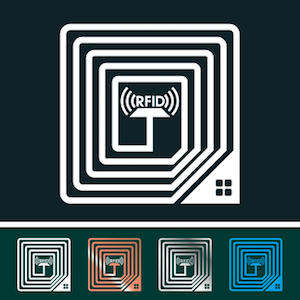What is RFID? Types of RFID Tracking Tags, Their Uses, Disadvantages and How They Compare to Barcode Labels
A Definition of RFID
Radio-frequency identification, or RFID, utilizes radio waves to read and capture information on RFID tags. RFID tags are embedded with a transmitter and receiver and may be placed on objects and items that need to be tracked for inventory or other  purposes. The RFID tags include a microchip that stores and processes information and an antenna to receive and transmit signals. An RFID tag also contains a specific serial number for the object on which it is placed. A two-way radio transmitter-receiver emits a signal to the tag using an antenna to read the information encoded on it. The tag transmits information written in its memory bank to the reader, which then transmits the information to an RFID computer program.
purposes. The RFID tags include a microchip that stores and processes information and an antenna to receive and transmit signals. An RFID tag also contains a specific serial number for the object on which it is placed. A two-way radio transmitter-receiver emits a signal to the tag using an antenna to read the information encoded on it. The tag transmits information written in its memory bank to the reader, which then transmits the information to an RFID computer program.
Types of RFID Tags and RFID Systems
There are two types of RFID tags: passive RFID tags and battery-powered RFID tags. Passive RFID tags use the reader’s radio wave energy to send its stored information to the reader. Battery-powered RFID tags are embedded with small batteries that power the relay of information.
There are three different types of RFID systems, which vary by the frequency band within which they operate: low frequency, high frequency, and ultra-high frequency. The frequency simply means the size of the radio waves used to communicate between the RFID tags and readers. Because the radio waves behave differently at each frequency, there are pros and cons of using each.
Low-Frequency RFID (LF RFID) – LF includes frequencies from 30 KHz to 300 KHz. This band provides a short read range of 10cm, has lower read speed than higher frequencies, but it is not as sensitive to radio wave interference. LF RFID often is used for access control and livestock tracking.
High-Frequency RFID (HF RFID) – The HF band covers frequencies from 3 MHz to 30 MHz. HF systems are moderately sensitive to interference. HF RFID is used for ticketing, payment, and data transfer applications.
Ultra-High Frequency RFID (UHF RFID) – The UHF band covers the range from 300 MHz to 3 GHz. The read range of passive UHF systems may be as long as 12m, and UHF RFID has a faster data transfer rate than either LF or HF. UHF RFID is the most sensitive to radio wave interference. UHF RFID commonly is used in retail for managing inventory (aka RFID inventory management).
Disadvantages of RFID
Because of the nature of RFID technology, there are several issues with it. First, there are several standards for RFID technology, and global standards have not yet been developed to help global companies navigate various networks within the supply chain. Some RFID devices are not intended to leave their networks, as is the case with RFID tags used for inventory control.
RFID systems easily become jammed because of their radio  frequencies. This creates longer waits in retail settings. However, in warehouses, disrupted RFID systems wreak havoc on an organization’s bottom line because workers cannot be productive or efficient when they cannot read RFID tags. Active RFID tags that use batteries to increase the system’s range also can be interrogated repeatedly, which wears down the battery and disrupts the system.
frequencies. This creates longer waits in retail settings. However, in warehouses, disrupted RFID systems wreak havoc on an organization’s bottom line because workers cannot be productive or efficient when they cannot read RFID tags. Active RFID tags that use batteries to increase the system’s range also can be interrogated repeatedly, which wears down the battery and disrupts the system.
Another issue with RFID in a warehouse setting occurs when signals from two or more readers overlap. This reader collision becomes problematic when tags are unable to respond to simultaneous queries. If RFID systems are not set up carefully and precisely, this problem becomes a common occurrence.
Consumers also face issues with RFID standards, as various companies create proprietary RFID systems. This means that one consumer may need to carry various RFID devices with them to use different systems for different companies, which is cumbersome and inconvenient. Or, consumers may need to pay to access various RFID systems.
RFID and barcodes automate the process of collecting data about inventory and assets. However, RFID systems experience interference and are difficult to use with metals and liquids because those materials cause more interference. Barcodes, on the other hand, are much less expensive and are not at risk of interference.